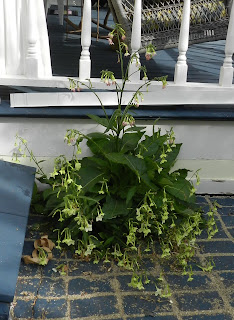This beautiful Nicotiana "Lime Green" is from Annie's Annuals and she referred to it as a plant that ties her garden together. It got me thinking about what's been successful in my gardens for tying it all together.
First off, what do we mean by "tying it all together"? It's flowers tucked here and there (strategically of course) that help a garden to:
One of the cheapest and easiest flowers for this is the annual marigold. Super hardy and blooms continually until frost. Thanks to hybridizing, they are not only gold, they're in yellow, combos with deep red and even white. Sized from a few inches to a couple of feet tall. They transplant easily and once established don't take a lot of watering. To keep them looking their best, I water when it's really dry and deadhead. I keep an old pair of kitchen shears in my garden apron and snip off old blooms while walking around.
I like the green Nicotiana and the very old fashioned fragrant white. I've used the pinks but they don't seem to get a bushy as I like.
For extremely dry areas, Rose Moss is an excellent low sprawling plant. Once established it goes until frost and sometimes overwinters or self seeds. They come in mixed bright or single colors.
If your area is shaded, the hardy hosta comes in so many sizes and patterns, it's impossible to run out of ideas. The leaves can form a dense background pulling other plants into a single picture. The good thing about most hosta, they can be easily divided allowing you to use the same look to unify the entire bed or shaded yard.
Another great shade tie plant is Impatiens. It does need moisture when it gets dry but what a great burst of color all summer.
Make sure you don't use something invasive for the purpose of tying things together. Some beautiful ground covers and grasses can easily take over and kill out other plants.
The trick with using one plant to tie in an entire area is making sure the "tie plant" is compatible to all the plants in the bed. It won't work if the tie plant is for full sun and the bed is mostly shade. Same with water and nutrient needs. Most succulents and hosta aren't friends in the same bed.
You don't even need to pack your beds with tie plants. Simply by planting the same plant somewhere in every bed can work. The eye will recognize that plant and the mind will consider it pleasingly familiar.
Using annuals as tie plants allows a change of theme every year. If you raise annuals from seed, it can be inexpensive.
As you dream your February garden dreams, consider a plant you L.O.V.E. and make it a tie plant.
First off, what do we mean by "tying it all together"? It's flowers tucked here and there (strategically of course) that help a garden to:
- Flow from one color, kind or size to another.
- Using one such plant, it can make different things look like they belong together.
- It can give different beds of different things a connection.
- It can brighten or soften other plants.
One of the cheapest and easiest flowers for this is the annual marigold. Super hardy and blooms continually until frost. Thanks to hybridizing, they are not only gold, they're in yellow, combos with deep red and even white. Sized from a few inches to a couple of feet tall. They transplant easily and once established don't take a lot of watering. To keep them looking their best, I water when it's really dry and deadhead. I keep an old pair of kitchen shears in my garden apron and snip off old blooms while walking around.
I like the green Nicotiana and the very old fashioned fragrant white. I've used the pinks but they don't seem to get a bushy as I like.
For extremely dry areas, Rose Moss is an excellent low sprawling plant. Once established it goes until frost and sometimes overwinters or self seeds. They come in mixed bright or single colors.
If your area is shaded, the hardy hosta comes in so many sizes and patterns, it's impossible to run out of ideas. The leaves can form a dense background pulling other plants into a single picture. The good thing about most hosta, they can be easily divided allowing you to use the same look to unify the entire bed or shaded yard.
Another great shade tie plant is Impatiens. It does need moisture when it gets dry but what a great burst of color all summer.
Make sure you don't use something invasive for the purpose of tying things together. Some beautiful ground covers and grasses can easily take over and kill out other plants.
The trick with using one plant to tie in an entire area is making sure the "tie plant" is compatible to all the plants in the bed. It won't work if the tie plant is for full sun and the bed is mostly shade. Same with water and nutrient needs. Most succulents and hosta aren't friends in the same bed.
You don't even need to pack your beds with tie plants. Simply by planting the same plant somewhere in every bed can work. The eye will recognize that plant and the mind will consider it pleasingly familiar.
Using annuals as tie plants allows a change of theme every year. If you raise annuals from seed, it can be inexpensive.
As you dream your February garden dreams, consider a plant you L.O.V.E. and make it a tie plant.





No comments:
Post a Comment